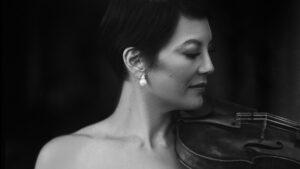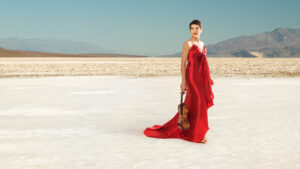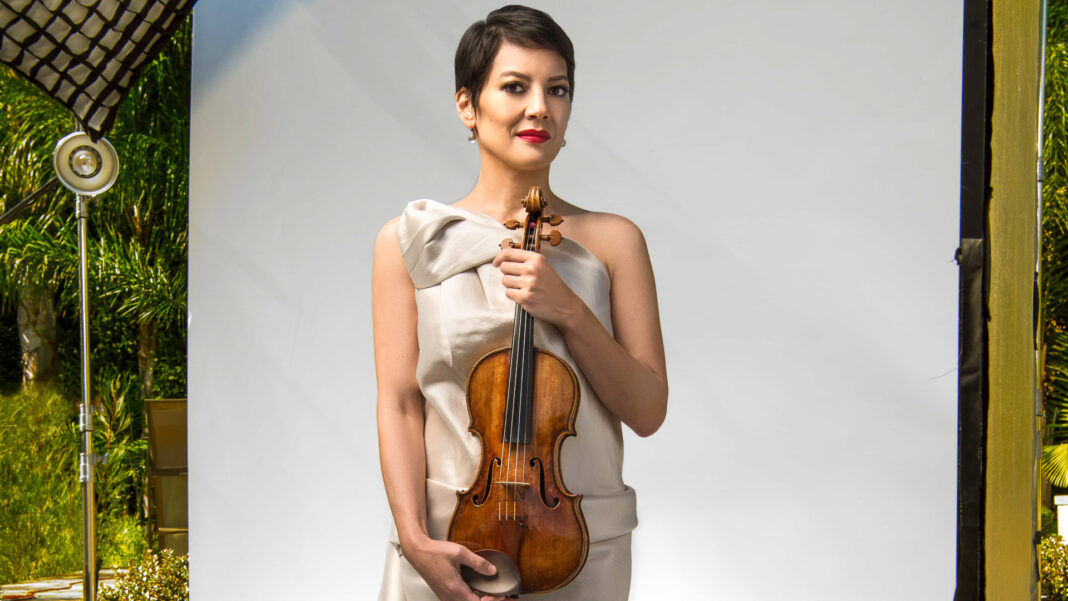There are two videos that offer up the best representation of acclaimed violinist Anne Akiko Meyers. The first took place when she was just twelve years old and was interviewed for Eye on LA, a local television series that was broadcast on the ABC affiliate in Los Angeles. In this video you get a strong sense of just how passionate she was about playing the violin, an instrument she refers to in the interview as her best friend.
The other video is from five years ago and features Meyers answering twenty questions for the Violin Channel. In this video you get a great sense of how seriously she still is about her music, but Meyers also reveals herself to have a great sense of humor, a definite joive de vivre and that she doesn’t take herself too seriously.
I encountered both sides of Meyers when we spoke last week via Zoom in what was one of the most thoroughly enjoyable interviews I’ve ever done. We came together to discuss her upcoming schedule.
She will be performing a recital at The Wallis in Beverly Hills on October 2nd. Five days later she’s performing two concerts with the Seattle Symphony. Before both those engagements she performs the National Anthem on October 1st at Dodger Stadium.

We spoke about the recital program that finds her joined by pianist Fabio Bidini performing works by Ludwig von Beethoven, Arcangelo Corelli, Morten Lauridsen, Arvo Pärt and Astor Piazzolla. We also discussed working with composers like Pärt and Arturo Márquez. Meyers gave world premiere of Fandango by Márquez at the Hollywood Bowl this summer and will be performing the work again in Seattle. This is a reflection of her long-held passion for working with new composers. Meyers also reveals the questions she’d love to ask some of the greatest composers of all time.
What follows are excerpts from our conversation that have been edited for length and clarity.
When you were asked about working with composer Adam Schoenberg on Orchard in Fog, you told Mood Blog you went through the piece slowly, “looking for clues to find the storyline”. Is that something you regularly do with every piece of music old or new?
I’m always looking for the song and the story within the music. I mean, that’s just my my end game. It could be anything. [Antonio] Vivaldi’s Four Seasons, which is like a very transparent story, but also something more abstract like Stravinsky or a new piece by whomever. There’s always an interesting story woven through it that just speaks to me and I just really respond to.
How much you think that story gets translated to the audience and what is your role in getting that story across to the audience?

I’m always one for just absorbing the moment and not needing a theory or some kind of educational component to go with it. As soon as I can absorb the music, like the pieces of Arvo Pärt or Arturo Márquez and these great living composers and hear their music and what they’re trying to convey, it almost becomes like reading a book. It’s like this is how I see this painting and this is how I want to share my ideas with the audience.
I think it just should be part of one’s imagination. There shouldn’t be like a story, guideline or something to follow intellectually to understand the music. It either moves you or it doesn’t – simply put.
Fandango by Márquez is just the most recent example of your working with living composers and giving life to new works they’ve written. What satisfaction does this aspect of your career give you that playing the standard repertoire does not?
I have been in this career or this music world for most of my life – almost 50 years. It’s hard to fathom. I’ve always just been in love with composers that are kind of undervalued and it started with the [Samuel] Barber Violin Concerto. That was my choice right off the bat when I was 18 – to make my first record with the Royal Philharmonic Orchestra in London. Hardly anyone was playing that concerto then.
Just to work with a living composer and to be in the same room with them. I’m just in such incredible awe of their minds and how much they can hear it inside and out; to actually collaborate. Even recently with Arvo Pärt when I was playing the beginning of the Fratres, his very difficult cadenza, in front of him, the orchestra and the conductor.
I know he liked this pretty insane tempo of super tendonitis-inducing speediness. I did my best to try to get to that tempo and I was breaking my hands. Finally I play it. And then he just said, “Stop, come on, why do you play this so fast?” And I said, “You wrote it. That’s what you put in the marking in that score.” “Don’t pay any attention,” he said. I just wanted to hug him.
You’re putting yourself out there. You are entering into the unknown. A lot of artists tell me that they don’t want to do anything unless there’s an element of risk or fear in it. It appears that with all these composers with whom you’ve commissioned work over 20 years this is right in line with the doing something that scares you.
There’s always that risk. It’s terrifying. You’re completely walking a tightrope over the Grand Canyon and just stay calm. If you fall off, there’s going to be no consequences. But just breathe through it. Each one is a very unique experience, a very unique child to the world, and they have to find their legs. It’s not for me to force it upon people to be like this is really great. You must listen to it. It’s definitely a risk, but it’s one that I love.
Do you often wonder what it would have been like to have these same experiences with composers of the past?

It just always goes through my mind, like, if I could just go back in time and rattle Chopin, Rachmaninoff, like all these great masters, Ravel. Have you thought of writing a fantasy? Have you thought about writing a violin concerto? Could you? These [contemporary] composers are just so grateful to be asked and so thankful; like I didn’t think of that, you know, that’s not part of my repertoire.
It becomes really a collaborative, empowering moment when they’re inspired by your question. And I’m completely motivated and inspired to not only make them happy, but to carry on the violin tradition and to bring these incredible composers and music to more generations of music lovers.
I want to end by asking you about something that Jascha Heifetz was quoted as saying. He said “There is no such thing as perfection. There are only standards. And after you’ve set a standard, you learn that it was not high enough. You want to surpass it.” Do you agree with him? And if so, why?
Absolutely! I mean the drive that that man had. Wow! I’ve almost never seen playing of that caliber. It’s just freaky how unbelievable of a player he was.
I am there for the music, one million, gazillion, trillion, percent. I think that I always am demanding the most from myself and pushing myself to places I never would have dreamed of going. The violin is my voice. When you have so much to say what it comes down to it is are you transporting yourself and the audience with what you have to say through your music.
For tickets to the October 2nd recital at The Wallis in Beverly Hills, please go here. For tickets to the October 7th performance with the Seattle Symphony, please go here. For tickets to the October 9th performance with the Seattle Symphony, please go here.
All photos of Anne Akiko Meyers by David Zentz (Courtesy Colbert Artists)












